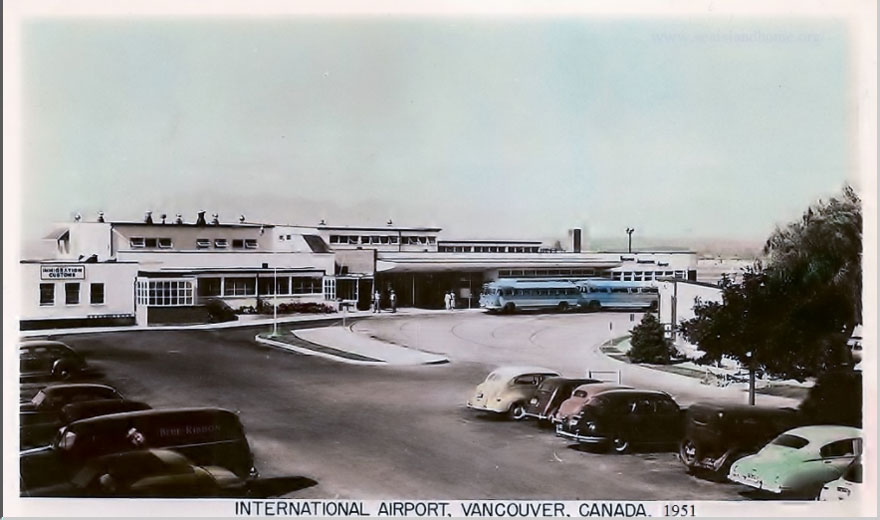World War II and RCAF Station Sea Island – 1940s
The outbreak of World War II meant great changes at the airport. As the only established airbase on the West Coast available to the Canadian armed forces it became a defence zone operational base of the Royal Canadian Air Force (RCAF) known as RCAF Station Sea Island.
During WWII, the authority regarding Vancouver Airport was assumed by the Federal Government, with the special committee continuing to function in the daily operation of the airport.
In 1941, plans were underway to build Burkeville, a Sea Island community to house 300 families. This housing became a necessity with the establishment of the Boeing Aircraft factory at the airport. This meant the government expropriated more land. Farmland belonging to Ernest Cooney, James Erskine and Robert Boyd was expropriated and used to build Burkeville.
The Federal Government purchased more and more land for the airport expansion. In November 1942 the farms belonging to W.A. Hayward, James Williamson and Mr. McDonald were absorbed into the airport holdings and some roads were closed. The government also installed a chlorination plant close to the junction of Miller Road and Airport Road.
With the war effort, the idyllic pastoral landscape of Sea Island became a heated construction zone. Mud-coloured shacks and barracks were hastily thrown up to house the air force personnel while abandoned farmhouses waited for the wrecker’s ball to the clear the way for more building.
In 1947, the control of Vancouver Airport was returned to the City of Vancouver.
The airport continued to grow. It was renamed the Vancouver International Airport (YVR) in 1948.
In 1949, the administration of YVR was changed for the special committee method to the Vancouver Airport Board via by-law no. 3146. The Board consisted of five unpaid members functioning as the administrative body of YVR. That same year, the original YVR was destroyed in a fire. Work started on a new facility immediately. This new terminal opened in 1950.
Expansion of the Airport - 1950s
From 1890 to 1954 Sea Island was known for its dairies. In 1954, Frasea Farm owned by the Grauer family was sold due to the land appropriations for the Vancouver International Airport. The Grauer family also owned other farmland on Sea Island, which would be held in a legal dispute with the Federal Government for 30 years. The Frasea Farm was impressive with its large barns and dignified farmhouse. Although Frasea Farm was the largest dairying operation, there were many other dairies on Sea Island.
The late Gerald “Gerry” Bicknell said that in 1941 his family moved to Sea Island from Point Grey. His father, Mr. H. Percy Bicknell, was the manager of the Vancouver Cannery on Sea Island. The Federal Government expropriated the Bicknell’s Shannon Road property for airport expansion around 1950. The Bicknells moved to 198 McDonald Road on Sea Island. The Bicknell property was part of a small community at the southwest end of Sea Island, where the Acme Cannery and Vancouver Cannery, the Cork Mill and the Japanese Canadian community used to be. The Bicknells were neighbours to Doreen Braverman and her family.
In 1957, more land was purchased for what would become the very first jet-era aircraft hangar. This hangar now known as the BCIT Hangar, Building T-131 and the Britannia Hangar still stands at 5301 Airport Road South on Sea Island. It is recognized as a federal heritage building.
In 1958, the Bicknell family was further expropriated from their home at 198 McDonald Road. Gordon Bicknell, Gerry’s brother was also expropriated from his home at 503 Grauer Road, all for the expansion of YVR.
In 2000, Gerry Bicknell provided the Sea Island Heritage Society with a hand-drawn map of Sea Island showing the first airport in the 1950s, the canneries, farms and residents as he knew them when he lived on Sea Island. Gerry included a legend, indicating the location of the first airport (now the South Terminal) at number 12.

Hand-drawn map of Sea Island in the 1950s courtesy of Gerry Bicknell.
| Map Legend |
| 1 - Eburne Sawmill |
16 - Cannery site |
31 - Mr. & Mrs. Miller |
| 2 - Marine Gas Station |
17 - Indian Midden |
32 - Clarence Hoggard farm |
| 3 - Marpole Bridge |
18 - Japanese Boatworks (Baba) |
33 - Mike Murphy farm (best one to work for) |
| 4 - Eburne Post Office |
19 - Wharf 100' x 70'+ |
34 - Radar Tower WWII |
| 5 - Grauer Store |
20 - Japanese Boatworks |
35 - McDonald farm |
| 6 - Clausen (sp?) Blacksmith |
21 - Acme Cannery, 21(a) Thomas Goulding's Cork Mill |
36 - Musqueam Indian Reserve |
| 7 - Eburne Bridge |
22 - Japanese Boatworks |
37 - Tapp Road subdivision |
| 8 - Community Hall |
23 - Vancouver Cannery Donald Farm |
38 - Ralph McDonald farm |
| 9 - Burkeville |
24 - Vancouver Cannery Store |
39 - Duncan McDonald farm |
| 10 - Sea Island School |
25 - Marine Gas Dock |
40 - McDonald Beach |
| 11 - Dinsmore Island |
26 - Japanese lived in this area |
41 - Cora Brown subdvision |
| 12 - Site of 1st airport |
27 - Cannery Wharf |
42 - Dick Laing farm |
| 13 - Boeing site |
28 - Cline Hoggard farm (both sides) |
43 - Grauer farm |
| 14 - Seaplane base |
29 - Karl Hoggard farm |
44 - Army Barracks WWII |
| 15 - Terra Nova Cannery |
30 - Poplar Tree Stand |
45 - Dummy anti-aircraft gun (wood pole for barrel) |



